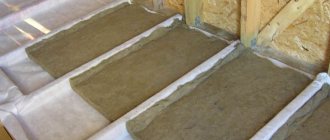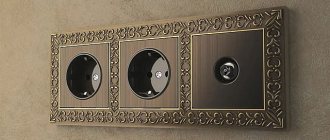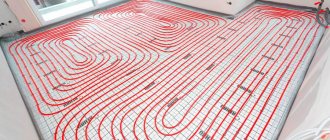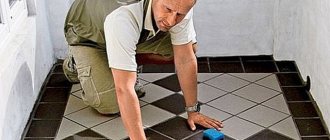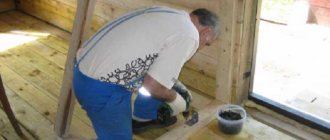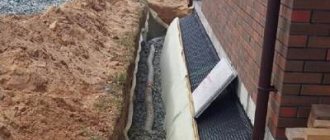Hello readers of my blog! Today we will talk about how to properly lay a warm electric floor with your own hands. It would seem that the matter is not tricky, but when you are faced with this problem, you have to think about how to do it correctly, what preparation to do, what materials to choose. Thus, I decided that this article would be useful to someone, and I am devoting my efforts to this subject. In it I will answer a number of questions that will arise immediately before How to properly install a heated electric floor with your own hands, and some even after that. This topic is quite broad, because before work, thorough preparation is necessary, but how to do this? And this is a separate topic. You can learn about all this in great detail in the article below.
What is a heated floor
How to lay a heated floor, or rather, how to properly lay a heated floor with your own hands so that it serves me as long as possible? I studied this issue from A to Z.
In this article I will tell you in detail about what an electric cable underfloor heating is and how to lay a cable underfloor heating with your own hands.
It's no secret that the most common type of underfloor heating is electric.
Where is it used? Everywhere.
Electric heated floors are easy to install and therefore can be found not only in apartments, private houses, but also in garages! There is no need to install any pipes, break down walls and needlessly irritate your neighbors. Laying a heated electric cable floor is not a difficult and not at all noisy task. And now you will see this.
What is cable electric underfloor heating?
Since a heated floor is called electric, it is absolutely clear that it is heated using electricity.
Or rather, an electric cable, which, heating itself, warms the floor. There are two types of such cables: resistive cable and self-regulating cable. What is their difference?
The first type of cable (resistive) heats itself due to the electricity that flows through it and heats the surrounding space, that is, the floor. The cable can be single-core or double-core.
Single-core is when there is only one wire running throughout the entire cable - the core. It is covered with braid and insulated. A two-core cable, accordingly, consists of two identical insulated conductors.
IMPORTANT! During installation, the single-core cable must begin and end in the same place. That is, it must be closed. This rule does not apply to a two-core cable.
IMPORTANT! Single-core and two-core resistive cables have two disadvantages - they emit an electromagnetic field (however, two-core cables are weaker). Heavy furniture cannot be placed on a resistive cable heated floor; the cable may overheat. The same can happen if the technology for laying resistive heated floors is broken.
The second type of cable (self-regulating) is much more complex and free of previous disadvantages. Accordingly, the cost of such a cable is much higher.
So, you have figured out the types of cable heated floors. Now I’ll tell you how to determine how much cable to buy?
What you need
It is very important to plan your budget correctly so as not to save not only on the heating elements themselves, but also on all building materials. High-quality waterproofing is especially important; in some cases it is a decisive factor.
To lay the floor you will need the following materials:
- the flooring system itself (heating elements and reinforcing mesh included);
- connecting wires;
- fastenings;
- temperature controller;
- temperature sensor;
- RCD protection system (residual current device);
- cement with sand;
- copper cable for grounding.
It is also necessary to purchase the flooring in advance in order to determine its thickness, texture and other aesthetic characteristics.
Material selection
The heating cable can have various designs.
Main types of cables:
- Self-regulating. The element is a polymer matrix. When overheating occurs in the fault zone, the current flow is reduced to prevent breakdown. The remaining areas are operating normally. Thanks to this property, a cable of this type has durability and high reliability, but is characterized by high cost.
- Resistant. Consists of one or two wires that have very high resistance. Passing through them, the current is converted into thermal energy. The heating core is protected by a layer of insulation and a metal braid responsible for grounding. However, if one section of the core fails, the entire system breaks down irreversibly.
Installation of the heating branch cable is carried out in a layer of cement fill, which will additionally redistribute heat and perform the function of insulation from cold from external sources.
How much cable to buy for electric floor heating
First of all, you need to measure the floor area on which you want to lay the cable heated floor. Install underfloor heating cable electric (unlike, for example, water) only on those areas of the floor surface where there is no furniture (cabinets, sofas, beds), plumbing fixtures or large household appliances (stove, washing machine, refrigerator).
The cable underneath may overheat. And why heat the surface under the furniture and waste electricity, and therefore money, on it? And this only reduces the warranty period of the floor.
Have you measured the area? Remember this number.
Better yet, write it down (for example, the floor area in my room is 9 m2). Now multiply it by the power of the heating system, which is per 1 m2 of room.
Now you have received the system power that you need to heat the entire area of the selected room (I multiply my 9 m2 by 150 W = 1350 W). With this number, feel free to go to the store, where a smart salesperson will help you choose a cable with the required parameters. Warm floors in the form of cables are most often sold in ready-made pieces of a certain size.
Necessarily! Ask the seller for the length of the selected cable.
This is where the fun begins in laying a warm electric floor with your own hands. This is the calculation of the so-called “step”. Pitch is the distance between cable turns.
It is measured in centimeters. We calculate how many centimeters should be left between the cables when laying it. To do this, multiply the area on which you decided to lay a heated floor by 100 and divide the result by the length of the cable (in my room: 9 square meters x 100 / cable length = step).
All! Now you know where to start laying a heated electric cable floor with your own hands.
IMPORTANT! Correctly calculate the required power of the future heated floor to avoid overheating of the cable.
And now the most important and responsible event - laying a heated floor with your own hands or installing it (as you wish).
Power calculation
To determine the power, you need to know the characteristics of all wiring and heating devices. Key indicators: length and power factor.
There is a special formula: P1 = P2 * S * K.
K – safety factor equal to 1.3...1.6. P1 is the power of the purchased cable, and P2 is the required heating power of one square meter of room.
However, classical norms are most often used. So, in a living room the power does not exceed 150-180 Watts, and on balconies and loggias - 180-230 Watts per square meter. It is not recommended to increase the power without a good reason, so as not to overload the system and not lead to wasted heat, which will be generated in excess.
Also, the power varies depending on the purpose: is it primary heating or additional heating. For example, if such a structure is the main source, the element should cover 70% of the floor surface. If the heating is additional, fill only the center of the room or areas not occupied by heavy furniture and household appliances.
For non-standard premises and in other cases requiring accurate calculations, special calculators were created. Let's take a closer look at them.
Calculator
A calculator for calculating the length and cable laying diagram can be found freely available on the Internet. The most important indicator is the cable pitch (the width of the stripes between adjacent wires in a loop). To calculate all parameters, you need to indicate the basic initial data.
We will need:
- total area of wire laying areas;
- specific power of the cable indicated in the passport;
- functional purpose of the floor (main or additional source, whether there are other heated rooms nearby).
The calculated value will help you make the right choice when purchasing a cable and calculating the insulation thickness. Knowing the length, you can calculate the step, which is on average ten centimeters.
Do-it-yourself installation of heated electric cable floors
What should you do first when laying any electric heated floor with your own hands? Select a thermostat and a location for its installation.
A thermostat is a device that controls a heated floor: it maintains the set temperature and regulates heating on and off. Choose a thermostat based on the power of your heated floor.
After you have chosen the thermostat and the place where you will install it, proceed directly to installing the thermostat and laying the heated floor, having first leveled the floor surface with a cement screed.
Apply damper tape around the perimeter of the room. Lay thermal insulation at least 2 cm thick. It is needed so that the cable heats only your floor, and not someone’s ceiling below or basement.
There are two main ways of laying heated floors - parallel and spiral. The names speak for themselves.
It is more convenient to install cable heated floors using the second method. You will need: mounting tape, cement screed, the cable itself.
The floor is ready. It is smooth and insulated.
Now lay and secure the mounting tape to the prepared floor surface. And mark the cable laying step on it. Remember you calculated it earlier?
IMPORTANT! The cable must not cross itself!
All that remains is to install the temperature sensor. In the prepared groove on the floor and on the wall (from the heated floor cable to the thermostat) we place a cable with a temperature sensor at the end.
Tip 1: To ensure that the temperature sensor serves you faithfully longer, protect it with a plastic corrugated pipe. A plastic corrugated pipe is a special hollow tube into which the temperature sensor wire is placed and the end is closed, for example, with insulating tape, so that nothing unnecessary gets inside the tube. Place the cable with the temperature sensor in a corrugated tube along the floor between the turns of the cable.
Tip 2: After laying the electrical cable for the heated floor, check its functionality.
That is, you take a special tester and measure the resistance of the laid cable. The data obtained should not differ from those indicated in the technical passport by more than ten percent. If you don't have a tester, just connect the cable to electricity and at least check whether it heats up or not.
Everything is fine? Now you have come to the finish line. All that remains is to fill everything with cement screed.
The thickness of the cement screed should be from 3 to 5 cm. Leave the screed to dry. After it has dried (28 days are recommended), you can begin connecting the cable heated floor to electricity.
Connect the temperature sensor, floor cable wires, and electrical wires to the back of the thermostat.
Tip 3: If you are not sure that you can connect the heated floor to the thermostat yourself, ask a professional to do it (for example, a neighbor - an electrician).
At this point, the installation of underfloor heating cable electric is completed. On top of a cement screed with an installed electric cable heated floor, you can lay floor coverings such as tiles, laminate, carpet, cork flooring, and so on.
Installation of electric heated floor
Cable heating systems can be installed in any premises, both residential, office or industrial buildings. Proper laying and installation of electric heated floors will ensure reliable and safe operation for many years. Installation of an electric heated floor begins with the preparatory work.
Preparatory work is carried out for one single purpose - calculating the required amount of materials and elements. The main task before laying an electric heated floor is to calculate the power of the heating cable.
Installation on a wooden floor
Wood does not conduct heat as efficiently as concrete, but installation on it is also feasible. For this purpose, distribution plates made of aluminum are used. The pipes are laid in wooden grooves made by attaching pre-prepared boards.
For installation of linoleum, carpet and other materials that require a flat surface, a leveling layer of chipboard, plywood or gypsum fiber board is laid over the pipes. If parquet or laminate is used as the finishing coating, the design of the heated floor can be slightly simplified, without the use of a leveling layer.
When choosing plywood and chipboard, make sure that they have sanitary, hygienic and thermomechanical characteristics that allow them to be used together with heated floors.
Preparatory work before installation
Before we start work, let's sketch out a small action plan:
At the initial stage of installation, it is necessary to decide on the location where the thermostat will be installed. The thermostat is installed on the wall, like a regular switch, in the most convenient place at a height of at least 30 cm from the floor.
A hole is drilled in the location marked on the wall to install the thermostat. Perpendicular to the floor, from the installation location of the thermostat, a groove is made in the wall for laying the power wire and the floor temperature sensor wire in plastic tubes or corrugation.
First of all, the surface is cleaned of dust and debris; it should initially be smooth, without holes or drops. If necessary, the surface is leveled with a screed; the thickness of the screed should be at least 3 cm; if the layer is thinner, the screed will crack. The optimal thickness of the screed is 3-7 cm.
Before pouring the screed, it is necessary to treat the floor with a primer, this will improve the contact of the surface with the cement-sand screed. After the primer has dried, you need to mark the places where installing a heated floor is not required (stationary furniture); the distances from the walls to the heating cable are also taken into account (at least 5 cm).
To heat a room more economically, it is necessary to reduce heat losses. To do this, a layer of thermal insulation is laid between the concrete base of the floor and the heating cable. The thermal insulation layer will make it possible to reduce heat loss by up to 30%.
VERTICAL - along the perimeter of all walls at the base of the floor. For this purpose, thermal insulation in the form of a special damper tape or ordinary polystyrene sheets 15-20 cm wide and about 1 cm thick is suitable. Insulation laid in this way will reduce heat loss through the outer walls of the room;
HORIZONTALLY - sheets of heat-insulating material with a thickness of at least 2 cm are laid on the concrete base of the floor, close to the vertical insulation.
Thermal insulation material must be mechanically strong and resistant to thermal influences. You can use material from such compositions as polystyrene foam, polypropylene foam, cork agglomerate, fibrous-mineral boards, etc.
If an electric heated floor is installed in rooms with high humidity, a waterproofing layer is laid on top of the thermal insulation. This will prevent moisture from penetrating into the subfloor. This is especially true in apartments, so that in the future there are no problems with neighbors downstairs.
What are the consequences of incorrect installation?
Installation errors or improper operation can lead to multiple problems. However, there is no need to worry - they do not pose a danger to human health and life. But it’s still a pity to spend money, so it’s better to start installing heated floors with your own hands when you have the proper level of skill and experience.
The most common negative consequences:
- incorrect thermal conditions (for example, overheating under massive furniture);
- failure of the entire system due to breakdown of the sensor, wires or other elements,
- insulation failure leading to overheating of wires;
- “leakage” of heat due to improper thermal insulation;
- curvature of laminate and other finishing coating.
To avoid such troubles, you should follow all the rules when installing a heated floor.
Preliminary cement-sand screed and fixing the mounting tape
Before laying the heating cable, a cement-sand screed is poured onto the thermally insulated surface. The screed layer will help prevent overheating of the heating cable, and will also create a solid base for laying the heating cable.
If for some reason it is not possible to organize a preliminary screed, you can lay the cable on a metal mesh laid out on top of the thermal insulation (with a fine mesh of 1-2.5 cm). The mesh, in this case, together with the heating cable laid on top of it, is filled with the finishing screed in one step. Due to the metal mesh, the screed is strong and monolithic.
After the cement-sand screed has sufficiently hardened, the floor is covered with special foil-coated thermal insulation (installation foil). The entire surface of the floor is covered with foil, it is laid with a reserve at the joints, and the edges are glued with foil tape so that they do not wrap during the installation of the cable.
Such a heat-leveling screen in the form of foil will promote uniform heat distribution over the entire surface of the heated floor.
To securely fix the heating cable, use mounting tape. Lay the mounting tape on the floor surface every 50 cm and secure it with ordinary nails or self-tapping screws.
To fix the cable on the mounting tape, special brackets are provided, located at equal intervals from each other along its entire length (usually 25 mm). Using these brackets, it is easy to maintain the required cable laying spacing.
Installation of heating sections
First, you need to return to the previously drawn up plan for laying the heating cable, carefully study such details as the order and step of installation.
Before unwinding the cable, you need to check its resistance.
The value of the measured resistance is recorded in the warranty card. It must match the one indicated on the cable sleeve label. Acceptable discrepancy ± 10%.
The cold end of the two-core heating cable is inserted into the corrugation and installed in the initially prepared groove. The coupling and the beginning of the cable are fixed to the floor to the mounting tape and cable laying begins from this place.
Moreover, the coupling must be located on the floor in such a way that it is completely filled with concrete screed.
During the installation process, you need to ensure that the cable lines do not touch or cross, and also strictly observe a constant laying step throughout the entire heating area. In places where cable bending is required, the bending radius should not be less than 5 cm.
The end coupling of a two-core heating cable is fixed on the mounting tape with the same condition as the connecting one - it must be completely covered with a concrete screed. If a single-core heating cable is used to install a cable heating system, then when drawing up the installation diagram, you need to take into account that both ends of the cable will be connected to the thermostat.
Installing and securing the temperature sensor and thermostat.
When the cable is laid completely over the entire surface, you need to install a temperature sensor. It is mounted in a corrugated tube and installed together with the supply end of the heating cable in one groove. A plug is placed at the end of the tube where the thermostat will be located to prevent solution from getting into it.
The tube with the sensor is laid on the floor, between the heating cable lines without crossing them.
In order for the temperature sensor to function normally, it and the tube are fixed in the middle of the cable lines on the mounting tape. The floor temperature sensor with a tube must be located along a cable at least 50-100 cm in length.
The thermostat is installed and connected after three wires have been connected to the junction box: the floor temperature sensor wire, the heating cable power wire and the 220 V mains wire. It is prohibited to place the thermostat in rooms with high humidity. It is not safe!
At this stage, the installation of the electric heated floor is completed. You can start pouring the heating cable system with cement-sand screed.
Water circuit installation diagrams
Schematically, laying pipes for arranging a liquid circuit can be done in one of the following ways:
- coil;
- double coil;
- snail.
Coil . The method of laying such a contour is the simplest and is performed in loops. This option will be optimal for a room divided into zones with different purposes, for which it will be convenient to use different temperature conditions.
The first loop is installed around the perimeter of the room, then a single snake is inserted inside. Thus, a maximally heated coolant will circulate in one half of the room, while a cooled one will circulate in the other, and accordingly the temperature will be different.
The coil turns can be spaced evenly, but the bends of the water circuits in this case will have strong creases.
The serpentine pipe placement method is ideal for rooms with little heat loss. They are used not only for apartments and private houses, but also for industrial facilities where there is a need to heat all year round
Double coil . In this case, the supply and return circuits are located next to each other throughout the room.
Angle coil . It is used exclusively for corner rooms where there are two external walls.
The advantages of the serpentine shape include simple planning and installation. Disadvantages: temperature changes in one room, pipe bends are quite sharp, so you cannot use a small pitch - this can cause a pipe break.
When laying the contour in the edge zones of the room (floor areas where external walls, windows, doors are located), the pitch should be smaller in comparison with other turns - 100-150 mm
Snail . Using this arrangement, supply and return pipes are installed throughout the room. They are placed parallel to each other and installed starting from the perimeter of the walls and moving to the center of the room.
The supply line in the middle of the room ends in a loop. Next, parallel to it, a return line is installed, which is laid from the center of the room and along its perimeter, moving towards the collector.
The presence of an external wall in the room may require double laying of pipes along it.
Due to the alternation of two lines when laying using the snail method, temperature fluctuations in the supply and return lines can be up to 10 °C
The advantages of this method include: uniform heating of the room; due to smooth bends, the system has little hydraulic resistance, and savings in consumables can reach 15% compared to the serpentine method. However, there are also disadvantages - complex design and installation.
Installation of cement-sand screed or self-leveling floor.
Before you fill the cable heating system with screed, you need to make sure that it is working. To do this, the heated floor is turned on briefly. A diagram of the installation of warm flooring with the placement of connecting and end couplings must be sketched, or better yet, photographed and included in the warranty card.
It is better to prepare a screed for electric heating from mixtures specially designed for this purpose. It is necessary to pour the liquid cement-sand mixture over the floor surface evenly and carefully, without damaging the cable insulation.
It is necessary to ensure that no air pockets arise during the screed pouring process, as they impair the heat transfer of the heating cable.
The thickness of the screed should be approximately 3-5 cm. The time for complete drying of the screed is indicated by the manufacturer of the mixture (approximately 28 days).
After the screed has hardened along the walls, it is necessary to cut off the protruding parts of the insulation (if any). Then you can begin laying the flooring (ceramic tiles, etc.).
If during its service life the temperature sensor fails, it can be easily replaced by pulling it out of the corrugation through the thermostat box. That is why the temperature sensor must be mounted in the tube. Electric heated floor
Warm floors with electric and water heating are becoming increasingly popular.
The latter often serve as the main heating system for private houses, and electric floors are widely used for additional heating of rooms. This factor, as well as a number of other reasons, made electric heating more popular.
We propose to consider the design, principle of operation, as well as the possibility of independently installing electric heated floors.
Which system to choose
Underfloor heating systems are divided into water and electric. Both types are in demand, and it is impossible to say unequivocally which one is better. To make a choice, you should familiarize yourself with their characteristics and compare the pros and cons.
Water floor
The main condition for installing water floors is the possibility of direct connection to the central heating system or the installation of a separate boiler room. In apartment buildings, such floors can only be used if they were originally included in the project. In standard city apartments, their installation is prohibited, since the water pressure in the system is designed exclusively for radiator heating.
Water heated floor
For the installation of heated floors, metal-plastic or polymer heat-resistant pipes are used, thanks to which the system functions uninterruptedly for 40-50 years, subject to proper installation and connection. This type of heating is low temperature and is most often used as auxiliary heating. At the same time, it can also act as the main source of heat, especially for small rooms.
Pipes for water heated floors
The structure of a polyethylene pipe
Table of characteristics of polypropylene pipes
The system consists of a distribution unit, which includes a manifold, pump and mixing unit, and a heating circuit. The optimal area for heating with one circuit is considered to be 10-15 m2, so for large rooms a system with several circuits and the ability to separately turn off each of them is designed.
Manifold diagram for a warm water floor
Advantages of a water floor:
- long service life;
- low energy consumption;
- safety;
- There are no restrictions on the placement of furniture.
Minuses:
- complexity of design and installation;
- large thickness of the structure and, as a result, high load on the base;
- in case of leakage, a major overhaul of the floor and a complete replacement of the circuit is required.
Electric floor
Electric underfloor heating systems are equipped with various types of heating elements, and depending on this they are divided into cable, film and thermomats.
| Floor type | Characteristics |
Cable | The most common type, characterized by the simplicity of the device. Mounted in a screed or a layer of tile adhesive, it is convenient when laying in a small area. The cable is supplied completely ready for installation, so it cannot be shortened or extended. To avoid overheating, furniture should not be placed above it after installation. |
Film | It consists of thin strips of heat-resistant polyester with heating elements sealed inside. This device provides very fast and uniform heating. Film floors are assembled from separate parts at the installation site and laid directly under the floor covering. They cannot be installed in screed and tile adhesive, since the alkaline environment destroys the film |
Thermomat | A type of cable system. Available in thin rolls of fiberglass with an attached cable. When installing on difficult surfaces, it is permissible to trim the fiberglass to make it more convenient to unfold part of the section. The use of electrical mats greatly simplifies the installation of the system |
Prices for heated floors Caleo
warm floor caleo
Types and design, as well as features of heating elements
A single-core wire or a two-core cable is most often used as an electric floor heating element.
The first option is notable for its low cost, but the increased background EMR imposes restrictions on its use in residential premises. The heating cable has two cores, one of which plays the role of a regular conductor, and the second - a heating element. This design can significantly reduce electromagnetic radiation, but increases the cost of the product.
More detailed information about the above heating elements can be found on the pages of our website.
Installation can be greatly simplified if you use a heating mat. This design is nothing more than an ordinary thermal cable laid with a certain step width on a reinforcing mesh.
As a rule, the width of the mats is about 0.45-0.5 m, and the length can vary from 0.5 to 12.0 m (accordingly, the maximum heating area for one segment is limited). There is no standard for mat sizes, so they may vary slightly from one manufacturer to another. The electromat, like the thermal cable, is a solid structure, the footage of which cannot be changed arbitrarily.
Rod structures are considered a subtype of electric mats. They use special carbon rods with the addition of copper and silver as heating elements. Heating elements are connected in parallel with a certain step.
The main advantage of this design is self-regulation. That is, if the temperature on any rod has increased due to poor heat transfer (for example, furniture has been placed), then the heat release is reduced. Thanks to this property, you can lay the mat over the entire area of the room.
Infrared film. This heating element became widely available relatively recently, literally at the beginning of the century.
The term “infrared” used in the name is a marketing ploy aimed at distinguishing this product from a number of other heating elements.
As you know from a school physics course, infrared emitters are also called thermal, therefore, any heating device can be classified in this category. The design of the film infrared heating element for a heated floor is shown in the figure below.
Typical technologies for laying electric heated floors
Before presenting several installation schemes, it is necessary to explain what affects the design. These factors include:
It should be taken into account that the minimum thickness of the thermal coating is selected based on strength criteria. At the same time, the installation technology does not allow unreasonably increasing the thickness of the screed, since this affects the inertia (time) of heating (the floor takes a long time to heat up). Accordingly, the sensor of such a system may not have time to respond to changes in daily temperature.
On the other hand, a 60-100 mm coating in such a situation can accumulate heat. With this option, you can make a reserve of heat, including heated floors at night, when a preferential tariff is in effect.
Types of pipes used
Three types of pipes are suitable for a warm water floor.
- Pipes made of cross-linked polyethylene (PEX-EVOH-PEX) are inconvenient to work with because it is difficult to give them the desired shape (they straighten when heated). But they are not afraid of liquid freezing and are repairable.
- Metal-plastic pipes are the best option: low price, easy to install, and keep their shape stably.
- Copper pipes are expensive; when used in a screed, they must be covered with a protective layer to prevent alkaline attack.
Instructions for laying an electric floor on an old subfloor
If you make fasteners on concrete, then the heat loss as a percentage will be about 30-35%.
Provided that the axis of the thermal cable is located at a distance of 10.0 mm from the base, and the pitch is 70.0-75.0 mm. In this case, you should opt for a cable with a rating of 10.0 watts per meter. The cable is attached to the base using mounting tape (you must first lay insulation on the base).
An even layer of tile adhesive is applied on top. When it dries, you can lay tiles without a screed or other covering in compliance with the technology of its installation, for example, pre-lay a bed under the laminate before installing it.
Laying in grooves
If conditions do not allow raising the floor to the required level, it is possible to wall up the thermal cable in grooves. It should be noted that this technology is unacceptable for shell rock, foam concrete or other material with low thermal conductivity.
This method is not acceptable for insulating load-bearing floors, since it violates their strength. As a rule, it is used to warm up open areas.
The technical characteristics of the thermal cable in such cases are selected based on the depth of the groove. If they are no more than 10.0 mm, then you can use a low-power heating element for a warm floor. When the depth exceeds 20.0 mm, the power consumption can be increased to 17.0-18.0 watts per meter.
Correct installation of the intermediate screed
This method can significantly reduce heat loss. Below is a table of heat loss.
Based on the table above, it can be stated that the maximum thickness of the screed may not exceed 20.0 mm. If the base is located above an unheated area (for example, a balcony, loggia, etc.), it is advisable to increase the heat-insulating layer to 40.0-50.0 mm.
The best solution is to reinforce the intermediate screed with polypropylene fiber. The further procedure is the same as for point 1 (installation on the old base).
Application of thermal insulation
Electric floor heating elements are mounted on an insulated surface (gypsum fiber board, polystyrene or PVC boards, etc.).
It is desirable that the insulator have a foil surface. It should be located in the border zone, between the cement base and the self-leveling screed.
It should be noted that this installation option is not durable and reliable, but, nevertheless, its popularity is quite high, since it is easy to install.
Brief description step by step
Let's look at the step-by-step process of laying the floor.
Main stages:
- preparation of the base;
- laying out elements;
- sensor installation;
- system connection;
- filling with screed.
Let's look at each step in detail to know all the details of such an important but simple process.
Application of mounting grid
The most correct way to install a wired floor heating element is in this way. In this case, you need to secure the cable to the mesh with plastic clamps, as shown below.
After the term installation is completed, the assembled structure is slightly raised above the base (you need to place it on some support of the appropriate size), after which the pouring is done. As a result, we get a thin layer of reinforced concrete, inside of which there is heating wiring.
This method of termo installation allows you to create an economical and reliable heated floor with minimal inertia of heating temperature.
Dry screed technology
This option is no less reliable than described above. It is called dry because during the manufacturing process it does not need to be filled with concrete-sand mortar. Below we provide brief step-by-step instructions for installing and installing an electric floor in a house or apartment yourself:
Concluding the topic of laying electric flooring, it is necessary to refute the false statement that it is impossible to use it in a wooden house (or made of timber). Below is an example diagram for such an installation.
Laying infrared thermal film.
Concluding the section on laying electric floors, it makes sense to describe in detail this process for film coating due to its popularity. The materials we will need are:
When everything is ready, we proceed to installation, provided that the horizontal floor is level, the algorithm of actions will be as follows:
At this point the process is considered complete. Please note that this version of an electric heated floor makes it possible to repair it (replace heating elements). To do this, simply remove the coating.
Areas of application of electric flooring
Due to its specificity, heated floors are used in conjunction with centralized heating in houses and apartments. Here are a few examples of its effective use:
Heating of kitchens and rooms. This type of space heating helps normalize humidity and temperature. Uniform heating of the floor surface does not allow convection currents to arise, and the electronic thermostat automatically maintains the set parameters.
Use in damp areas. If you connect the system correctly (via an RCD or differential circuit breaker), and also ensure reliable grounding of the electric floor and install waterproofing, then you can take a shower without a tray or rubber mat.
Balconies and loggias. Even on a glazed balcony or loggia you can get a cold in the winter; the situation can be corrected by equipping them with electric floors. This is smarter than making a heating battery there.
Where can it be mounted?
Warm floors can be used almost everywhere. The electric version is installed in private houses, apartments, loggias, bathhouses and even garages. The water type takes up a lot of space, so it is not applicable in small apartments with low ceilings, but in large houses it is superior in ease of use to its electric counterpart.
A floor with heating elements can be used as the only or additional source of maintaining room temperature. However, it should be remembered that such a heating system is not a cheap pleasure. Be prepared for your electricity bills to skyrocket.
Advantages and features of heated floors
If we compare this technology with its water counterpart, for example, XL - PIPE, then the first thing that catches your eye is the price level.
Water systems are significantly more expensive than their electric counterparts. This is due to the fact that it is necessary to install expensive equipment, a liquid thermostat for system control, a boiler or boiler, etc., for all this you will have to pay a lot of money.
It is also worth mentioning about setting the parameters of thermostats in water systems; you won’t be able to use the remote control for this; you will need the help of a specialist. The electrical concept makes it possible to configure the controller yourself. The thermite user manual describes in detail how to do this.
On the remote control you can set the warm-up time, set the maximum temperature, check the serviceability of the main components, etc.
Peculiarities.
There is an opinion that electric floors are harmful due to the high level of EMR. This is not entirely true; a good European manufacturer will never put on the market a product that does not meet accepted standards. Actually, this is the answer to the question of which manufacturing companies are better.
The system is practically beyond repair, you can check the serviceability, search for a break, but the design of the cable heater is such that its repair is not expected.
On the other hand, the technology is designed to operate the system for 15-20 years. This is the period that assumes that new repairs will be carried out. Consequently, if the system barely heats or the heat spreads in places, dismantling is carried out to the base (tiles and adhesive coating are removed), after which a new installation of the heated floor is made.
It should be noted that this feature is also typical for water systems.
Please note that in some options for dry electric heated floors, it is possible to dismantle the coating, and therefore repair (to be precise, replace) the heating element.
Actually, the only serious drawback of heated floors is high energy consumption. Operating a water system is much cheaper.
Well, now it's time to finish the article. All the material I wanted to share has been reviewed. I hope it will be useful to you, and you will use it if you need to lay a warm electric floor with your own hands. Improve your own practical skills and gain new knowledge, as they say: “It’s never too late to learn!” That's all, thank you for your attention, successful and easy repair!
Connection
The heating element with a wire and sensors are connected to the thermostat according to the diagram specified in the instructions. Then it is necessary to connect the entire system to a residual current circuit breaker, the leakage current value is maximum 30 mA.
The check is carried out in various ways depending on the element:
- Cable and mats - the resistance of wires and elements is measured and compared with the passport characteristics (usually about 10%).
- You can simply touch the IR film. If it is warm, it means everything was connected correctly.
When installing a heated floor in a bathroom or bathhouse, you should connect the braid of the heating wire and the grounding wire. The use of grounding minimizes the risk of electric shock in the event of a malfunction.
Observe safety precautions: it is strictly forbidden to apply tension to the floor structure with screed or glue that is not completely dry!


